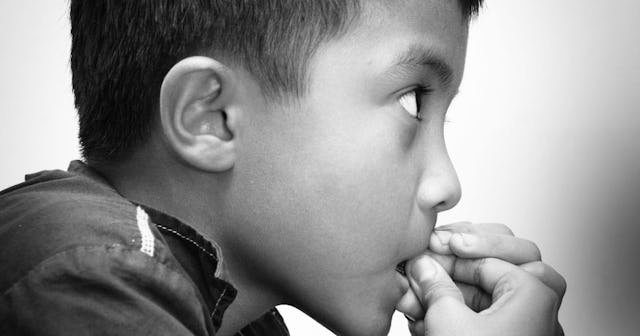My Son Has Dermatillomania

One of my sons has developed a worrisome habit over the past year or so where, when he’s zoning out on his iPad, he starts biting and picking at his toes. Not just your average nail/cuticle biting, but he goes into what I call “full gorging mode.” I won’t get into too many details here, because TMI, but let’s just say that the results from his picking/biting sessions are not pretty at all. The kid basically decimates his poor toes.
Luckily, this isn’t a daily occurrence, and things have slowed down considerably lately. Still, I’m concerned, and I’ve wondered at times what the heck is going on with him, and whether it’s time for us to seek professional help. I’m also wondering if the way I’ve handled it—which is to basically tell him to please for the love of god stop—is the right thing to do.
Tetiana Mandziuk/Getty
I caught up with Natasha Daniels, LCSW, child therapist and the voice behind the popular website Anxious Toddlers. She explained that skin picking is a common condition among children (and adults too). Often referred to as dermatillomania, the official term for it is excoriation (skin picking) disorder and it’s “classified as an Obsessive-Compulsive and related disorder in the Diagnostic and Statistical Manual of Mental Disorders (DSM-5),” according to Daniels.
Daniels emphasizes that the disorder is extremely common and highly treatable. When I asked her how to identify the disorder in your child, she shared that the most common symptom is a pattern of ongoing skin picking that often results in scabs or lesions (ouch!). She noted that you want to be sure the scabs and scars are not caused by another health condition.
But besides the physical symptoms, you should be aware of the emotional symptoms your child may be experiencing. Children with skin picking disorder feel unable to stop what they are doing. They usually find that the picking interferes with their ability to function normally. And they feel upset or embarrassed about the behavior, as well as the scars.
So what should you do if you feel that your child’s skin picking habit is interfering with their mental health and daily functioning?
“If you suspect that your child might have excoriation (skin picking) disorder, you want to go to a therapist that specializes in BFRBs (body focused repetitive behaviors) to have them formally assessed,” Daniels recommends.
And what role should a parent take in all this? Her next piece of advice was probably the most eye-opening, at least to me. Clearly, my hounding my son to just freaking stop picking already wasn’t exactly the best tactic.
“It is not helpful if a parent becomes the ‘picking police,’” warns Daniels. “This can ironically exacerbate picking behavior.”
Sol de Zuasnabar Brebbia/Getty
Guilt as charged—and I can totally see that whenever I tell my son to stop, he doesn’t take it well. I’ve even seen an uptick in his behavior when I do.
What should concerned parents do instead—besides, of course, seek professional help when warranted?
“The best thing parents can do is educate themselves and their child on what a picking disorder is and how it works,” says Daniels. “Often kids feel very embarrassed and alone and don’t realize that this is a common and highly treatable disorder.”
Okay, that makes so much freaking sense. I’m definitely going to try that next. I think it will give my son great comfort to know he’s not alone in what he’s doing, that his picking is nothing to be ashamed of, and that help is out there.
Daniels herself is a picker, and so is her own daughter—so she totally gets it.
She shared a mom-to-mom moment with me, explaining how she’s helped her daughter deal with her picking issues.
“I had to learn to not micromanage my daughter’s picking,” she said. “I empowered her by teaching her that the behavior had a name and that many kids just like her have struggled with this issue as well. Over time she developed the tools and skills to manage her own picking. Once I focused on educating and empowering her, she started to make progress.”
This is so encouraging. You can also check out Daniel’s YouTube video about this exact issue—and check out her YouTube channel for more excellent videos.
I love how she emphasizes that this is your own child’s journey—that your job is to provide information and support, but also that your child has to figure out for themselves what is going to work to help them stop the picking habit.
In the video, Daniels mentions that in addition to awareness—such as learning what the disorder is and what situations make you want to pick—having some tools available to help you combat the picking urge when it comes is a fantastic idea.
Kids can wear Band-aids or gloves to cover up the skin they normally like to pick. They can also keep their fingers occupied with fidgety toys. Daniels recommends the site Pickingme.org as great resource, and her favorite book for kids on the subject is What to Do When Bad Habits Take Hold by Dawn Huebner.
Oh my goodness, I feel so much more prepared for what to do next time my kiddo is sitting on the floor chowing down on his toes. I’m definitely going to offer him the Band-aids and gloves (or socks, in his case), as well as all the fidgety toys in the world. But I’m also going to validate his feelings, reassure him that he’s okay, and that there is nothing to be ashamed of.
Most of all, I’m going to stop nagging him about it, and try to assure him (and me) that this is something solvable, and that he’s totally got this.
This article was originally published on